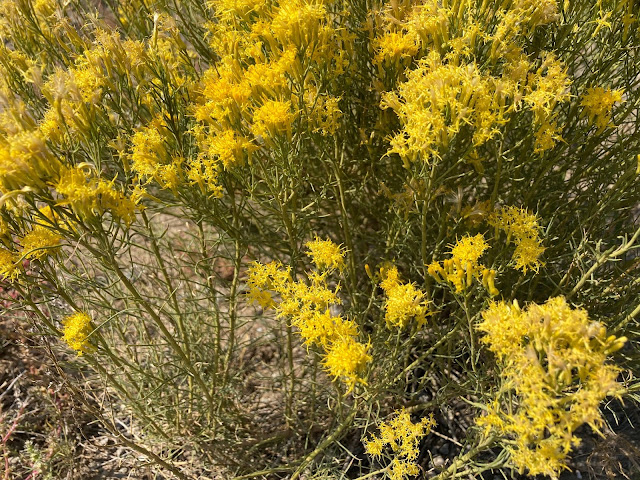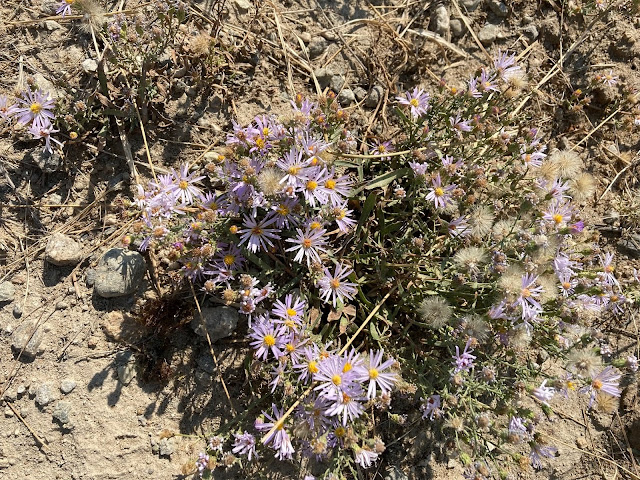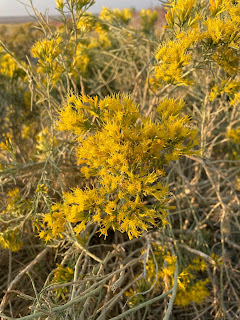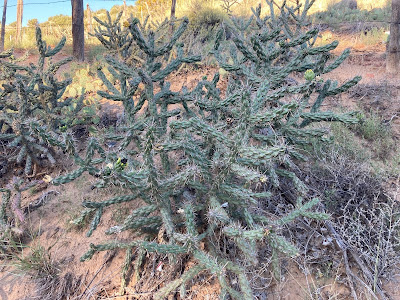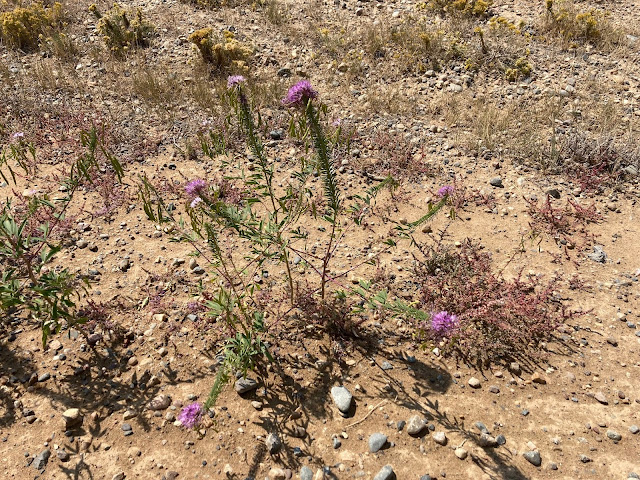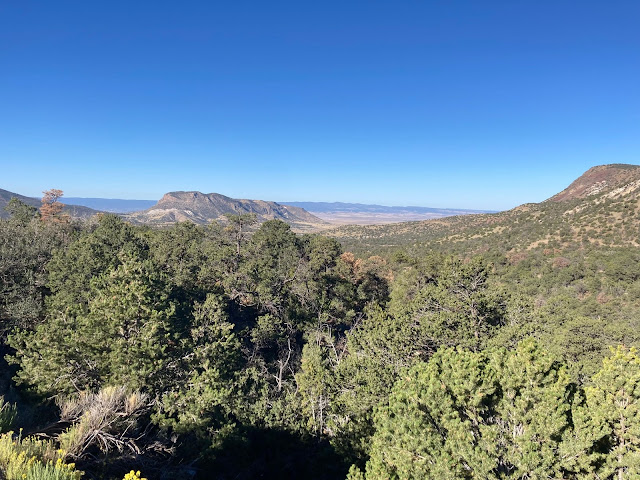Flowers along the trail, Wyoming to New Mexico.
Tim's Great Divide Ride
Tuesday, October 18, 2022
Desert FLOWERS
Monday, October 17, 2022
Ruminations 3: The RIDE
I was biking alone through a high valley and scattered showers on the climb up to Ute Pass in Colorado when car passed by with the passenger window down through which a middle-aged woman called “Congratulations!”
Congratulations? That gave me pause but I appreciated the sentiment. I think it meant “Good on you, but you must be a little off to be doing this.” I think people sell themselves a little short. The Great Divide Mountain Bike Ride is not for everyone but it’s hard to believe that the self-selected group of 2000 riders per year is the total number of folks who could do this ride. I tell people a couple things:
1. If you like or don’t mind being on a bike for 8-10 hours a day on hilly roads, and like biking and are reasonably fit, you could do this.
2. The physical demands are well-advertised and live up to the direction given in the guides. If you know that you have a 12,000 ft pass to ride over, then you are aware that it will be hard. The psychological demands anticipated in a very early post on this blog are probably less emphasized in the guides. The psychological and physical requirements are equally necessary to consider.
Other than that, more people could do this and not be scared away from the idea! So when you decide to gear up and do a ride like this, give me a call and I’d be glad to share more notes and thoughts, both technical and impressionistic.
The mapping and trail selection by Adventure Cycling Assoc gets some criticism from folks who think this should be strictly a mountain biking trail. In reality it is a linking of less-used road and trails that utilizes paved road connections when necessary. It is not a straight line, and doesn’t always seem logical. Even many experienced bikers avoid the single-track sections as being too demanding. I think it works very well since it is infeasible to create a new dedicated bicycle route up and over the Rocky Mountains. It does not go through major national parks intentionally; it does not bisect wilderness areas intentionally. It is a proven and well considered path. I would recommend this to anyone as a challenging route that gets you off the paved road, into less seen valleys and towns, follows the contours of the land, and provides a variety of roads and trails.
Paraphrasing Robert Frost, I took the road less-travelled and it has made all the difference.
Two days after the ride was complete upon arriving in Denver thanks to Andy, I started questioning whether I had really done the climbs, descents, passed through deserts and forests, worried about large mammals in the night, etc. For some reason, I already felt somewhat detached the minute my legs had little to do. Maybe I had just been focusing on the wedding celebration that was to come and compartmentalizing emotions. I expect that it may take months to fully appreciate the effort (congratulations!) but also the way in which every sense was alive to the changing environment whizzing by at bike speed.
It has been two weeks since I started walking again. Every night is full of dreams of biking: some are long uphills, some are technical with big rocks to negotiate, (even biking down an escalator in one dream) and some are long glides. Clearly, even if I feel detached in my waking hours, my subconscious is still out on the road, taking in as much as possible, anticipating the next climb, finding exquisite glory in the roll downhill.
Special Note on TJ Statt
Day 38 in the Great Basin. If you recall, TJ and I became separated that night after I had misinterpreted a “right-turn." TJ found the A&M Reservoir for water and I was down to ½ liter. For some crazy reason, we were able to text each other with an intermittent signal. When TJ realized I was out of water, he set out to find me in the dark, having no idea where I was. I texted him back that a man named Art had provided me with water for the night. Because of the spotty connection, TJ did not receive this message until he had gone 9-10 miles upon which he returned to his campsite. I found this out later and realized TJ hd biked 108 miles that day, adding on 20 to help this old guy he met in the desert. I would like to think I would have done the same but you don’t know until you have the chance. I’ll never forget this extreme act of kindness from a guy I met six days earlier. Thank you TJ.
Thanks to Molly
Most of these blog entries were tapped out on a phone in a dark tent each night and sent to Molly either when I had connectivity (reason for the gaps when we couldn't post) or by a satellite contraption. Pictures were sent in bunches. Thanks to Molly for making this blog “sing” with her editing skills: between formatting and editing text and typos (I have fat fingers) and inserting pics, each post took Molly about an hour. Huge commitment. Would not have happened without her talent and dedication.
Sunday, October 16, 2022
Ruminations 2: BIKEPACKING
Travel of any sort is revelatory and we never understand how much will be revealed to us until we hit the road. We can anticipate that there will be revelations but we can’t enumerate what they will be exactly. In the moments of traveling all becomes clear: Sights, sounds, climate, people, food, etc. We remember why we do this.
Bikepacking ratchets the experience up a few notches. In a country whose transportation mode is based overwhelmingly on gas-powered vehicles, being on a bike immediately puts you a bit on the outside of the culture. From this perspective the world is experienced at the speed it was meant to be experienced (in my humble opinion): not as slow as walking but certainly not at 75 mph where the passing landscape is literally blurred. The earth’s contours (up and down but also its horizontal displacements and curves) are felt to the point of exhaustion at times and pure pleasure at other times. Kind of hard to explain but I think it taps into our childhood joy of learning to ride a bike which most of us forget when we get our driver’s license.
From the perspective of a bike the people we encounter is unique to our mode of travel: there are others on bikes that share a common purpose and a natural affinity.
There are the curious, and those who have done something similar (a 75+ year old woman in a grocery store parking lot in Columbia Falls, MT stopped me and mentioned that she and her husband used to bike from CA to UT back in the day and felt the need to tell me that! I’m glad she did.)
There are those who move by quickly.
There are those that worry about you, those that show kindness and hospitality as mentioned throughout the blog.
And there are those who yell something unintelligible out the window at you, or downshift their diesel and cover you with black smoke, or refuse to give you much room on a narrow bridge in a crosswind. But these are a minority.
It's a terrific way to travel.
As a way of “paying forward” the kindnesses I received on this trip I would like to ask that if you are traveling in the late afternoon, or even coming home from work and see someone on a loaded bike, you can expect that he or she is coming to the end of their day, is probably pretty tired, and may need a kind word, or a bottle of water, or some other form of assistance. If you can muster the confidence, ask them how they are doing and if they need anything. Offer water or an apple. At the very least, you are likely giving them a little energy boost to make the last five or ten miles of the day, or in my case in the Great Basin, could be saving their health and their trip. It’s not much for us to do this; it can mean a world of difference to the bike packer.
Saturday, October 15, 2022
Ruminations 1: The WEST
It’s been two weeks since I started walking again. I think it’s about time to wrap this up with a few thoughts listed below. I will conclude this blog with a post on desert flowers: once you see that, it will be safe to say that you have seen and read it all. Thank you for joining me on this ride: knowing the blog was being read and followed encouraged me to stay sharp each day and try to communicate what I was seeing. You all contributed to the content with your questions but moreover with your regular attendance and focus! It kept me on my toes even if they rarely touched the ground.
The West
Ah, The West: is it the Best? Is the East the least? When I moved to Los Angeles when I was 14 years old, I heard that a lot. I also heard that the country is on a tilt and anything loose will roll from east to west…people included. But the west coast is not The West in the American imagination. 60 days gave me a glimpse into the culture of the west and perhaps a few insights into the cultural mythology of the west as represented in media, movies, books, and cigarette ads. Without any certainty here are questions bouncing around in my head.
No room for a treatise on this matter but here are some observations:
a. Cowboys: As you all know the GDMBR is a western trail and travels thru five western states all of which contain iconic imagery of what is thought of as the American West: dramatic mountains, broad grazing valleys, big rivers, buttes, high desert, cows, horses, bears, eagles, elk, ranches, cowboys riding horses….oh wait, where are the cowboys? In 2600 miles I saw one guy on a horse and the dude was pretty dressed up in completely black duds rounding up some free-ranging cows and seemed to be having a heckuva lot of fun for that kind of work. We were at the top of a ridge and this impeccably dressed guy came around a tree and nearly barreled over me in pursuit of a terrified cow. This guy did not seem in control of his situation nor dressed for it. Something seemed off and we decided among ourselves that the “round up experience” must be an amenity at one of the dude/guest ranches nearby. Maybe? I remember talking with dispersed camper Al Mota from CA prior to climbing Union Pass on day 34: he had a pistol strapped across his chest (forgot to ask what that was for) as he found a cold can of fizzy water for me. As he gestured to his (infernal) side-by-side vehicle, he said it was too costly to keep horses fed, watered, and healthy compared to the benefits of the side-by-side.
b. "Indians”: we noted very spare references to local reservations that we travelled through and past. I have commented enough on “naming conventions” but that was more obvious and pronounced. I think it’s possible that had I been more consciously aware of the various tribes in the area, I could have been more attuned.
c. Cowboys and Indians: TV, Saturday matinee, and cigarette ads (when we had them) may have had the most effect on shaping my western image and mythology. Several times while riding a historic railbed through a gorge, I could envision a train robbery by westerners or natives; while passing through northern New Mexico’s buttes and rock formations I imagined a line of horses and riders cresting those buttes. How much of this is myth and how much reality?
d. Who built the West? Self-driven western European settlers in Conestoga wagons and strong-willed individuals? Or immigrants from China and Ireland (railroads) and Eastern Europeans who were pressed into service without recognition (roads and towns), or Native Americans who were vital as trackers and guides to western explorers which eventually opened the west to commercial and military expansion. Probably all of the above in different configurations. Far more complicated that the typical narrative for sure.
e. Who is the West? To be sure we met some fascinating figures who seemed to have grown out of the land they were born into. And we met many others who had acclimated (easterners who had even taken on the twang we may associate with Montanans or Wyomingites). Still many other who are recent American migrants from CA, TX, and elsewhere who are taking advantage of the “remote work” option and buying up “ranchettes” with bespoke and curated names, resulting in higher land prices for locals. How will these states evolve politically, socially, and culturally with this most recent influx of newcomers?
f. Young folks are influencing the evolution of established towns. Latimer in Eureka, MT and Ike in Del Norte: two who want to see their towns flourish and be more inclusive even in small ways (even by pronouncing the “e” on the end of Norte!). There was an article in Conde Nast that mentioned Del Norte as a town that is recreating itself when so many other small towns are barely surviving (Basin, ID, Canon Plaza, CO, etc.)
g. These states, especially MT and WY, are extremely white. In these posts I have expressed at length how friendly and hospitable (not to mention life-saving) folks were to me in these states. No doubt about that. I want to believe I would have received the same care if I had been black or brown, or that my black friends would have felt the same hospitality. I hope so. And I am not holding up more color-ful cities and states as automatic paragons of interracial harmony. I just haven’t been surrounded by so many white people in some time!
h. The spatial dimensions of the west are unparalleled and this is what attracts me: the landscapes are truly breathtaking whether in the mountains of the plains. I have met a number of westerners who feel claustrophobic in the hollows and tree canopies of the east. The flora, fauna, and landscape between west and east is equally magnificent while being basically incomparable. When you are in the west, there is no mistaking it for New England.
i. From all outward signs, most of the towns I visited from MT to CO were pro-Republican and still supporting an ex-president that is anathema to traditional republicanism (hard to argue with that). I refrained from getting into politics, but when I did, the conversation remained cordial and usually was only a part of the overall conversation that included regional origins, weather, employment, bikes, adventures. My faith was restored not necessarily in Republicans and the state of the current party, but in the ability to have interesting and revealing conversations with people despite admitted differences in political perspectives. No small thing.
j. Getting back to the western myths: it occurred to me that the west was becoming something of a theme park: dude (guest) ranches with cow poking experiences, see horses but don’t ride ‘em, spurs on boots for looks or relics of a pre-ATV age—the logical conclusion to this could be an attraction as represented by HBO’s Westworld: the western “experience” without being “real.” On the other hand, this is not that much different than what is happening in other regions of the country, even in my hometown of Boston which has turned “tourist attraction” into an art form. Like other regions of the country, is the west becoming more of a “stylish” overlay than an integral culture?
k. Not sure why this is, but people talk loud in the west. I don’t know if they are trying to fill up the vast space around them or if they are going deaf from driving around in the Texas wheelchairs.
l. Free ranging managed ungulates (cows and bulls): The little I have read on this confirms a thought that free ranging cattle preceded the creation of national parks, government-owned/claimed land, and private property. It is practiced widely along the GDMBR. I have heard the fees paid by ranchers to the government to use this land for private cattle are low. Not taking into account the challenge and sometimes fun of getting around cows that periodically stand in the road, there are other environmental concerns: cow feces everywhere in grasslands and in forests (if these were dogs…), fouling otherwise uncontaminated water sources such as springs and streams, methane, etc. Of course these animals satisfy appetites for beef so we should not expect much will change. I also figured out that people put up barbed wire on their property not to keep cows in but to keep them out.
m. Naming conventions revisited: when I was leaving Denver I heard about a group of Arapahoe native Americans walking for a week from Sand Creek to prominent Mt Evans, one of the 14,000+ peaks that dominates the western skyline beyond Denver. It was named for John Evans, the 2nd Governor of the Territory of Colorado between 1862-1865, and one of the founders of Northwestern University and Denver University. The walkers were promoting a new name for the peak, Mt. Blue Sky, since Evans had instigated the massacre of Cheyenne and Arapahoe native Americans by the US Army in November 1864. It was one of the worst massacres in US history in which 675 troops killed or mutilated 150 people, 2/3 of which were women and children. It is likely this mountain will be renamed after 160 years.
n. Land of Many Uses: (National Forest slogan): could not find the origins of this slogan but it does mean different things to different people and different political parties. Look at Forest management policy especially in the last 40 years since Reagan. Running the gamut between opening up federal lands to drilling to protecting native and endangered species, your perspective on “use” may be wildly different than mine. In light of the beauty that is observable in our national forests, may I suggest changing the slogan to “Land of Many Wonders” and leave it at that? Might also change our approach to how we exploit to enjoy this resource. It’s ok to disagree!
All these things are curiosities; I am still overwhelmed by the intensity and often unforgiving aspects of “the west “ and can’t possibly appreciate or understand it fully without living out west for some time. I am grateful for the people I met, the conversations, the hospitality—all of which made the ride more enjoyable, friendly, and safe.
Note: the fundraising web site will remain open for the month of October! I am so grateful to have raised 88% of my goal for Apprentice Learning, a fantastic educational organization serving Boston middle school students. Many thanks to all who have donated, and thanks to anyone who would still like to donate and help me reach my goal.
Sunday, October 2, 2022
GDMBR By the Numbers
1 Great Divide Mountain Bike Ride
Day: time it takes on a bike that takes a car 45 minutes at 65 mph
2 Canadian Provinces: Alberta, British Columbia
Wheels (29” x 2.6” wide tires)
Days lost to rain (no travel)
3 Countries on the GDMBR: Canada, U.S., Mexico
Number of hailstorms
3.5 Liters of water carried on a regular basis
5 States to pass thru: Montana, Idaho, Wyoming, Colorado, New Mexico
Days, no travel
Travel companions more than one week: TJ, Eric, Andy, Noreen, Mark
6 Total days of rain
7 October, Erickson and Katie’s wedding
8 Weeks, start to finish
10 Teeth, on the smallest gear on the rear wheel
12 Gears on rear wheel cluster; good for climbing
13 Weeks, leave of absence
15 Years, time that Tim has been thinking about this ride
22 Pounds lost
27 Years, Tim’s age the last time he did something like this
30 September: ended trip
32 Crossings of the Continental Divide
37 Years since the last bike ride of any distance
40 Pounds per square inch, pressure in tires
60 Days, start to finish
64 Years, Tim’s biological age (27 years; how old he felt at the end of the trip)
70 Pounds, approximate weight of bike (loaded)
173 Pound, approximate ending weight
188 Miles, first leg of trip from Jasper to Banff, AB
195 Pounds; approximate starting weight of ride
1985 Year, last time Tim rode cross country
2,615 Miles ridden on 60 day period (385 miles saved for another day!)
3,000 Miles to ride on GDMBR
3,478 Feet: elevation of GDMBR starting point: Jasper, AB
4,665 Feet: elevation of GDMBR ending point: Antelope Wells, Mex
5,000 Calories, average burned per day
11,913 Feet; highest point on the GDMBR
152,243 Feet; accumulated vertical gain (29 miles! Five Mt Everests)
******Stay tuned—a few post-trip blog posts are still to come!******
TIME Warp
Day 61—Saturday, October 1—Grants, NM to Denver, CO
523 miles
523 miles takes at least 10 days in good weather by bike; 10 hours even by car in the rain, including stopping for gas, brunch, and to see the hot air balloon festival over Albuquerque. After 60 days traveling mostly at an average rate of 7 mph, it felt like a time warp to me.
The night at the KOA in Grants was the third worst besides Hartsel behind the bar, and Whitefish next to train. In Grants, freight trains ran all night and blew their horns loudly at grade crossings. Earplugs not much help.
Early morning farewell to Eric who may be facing some weather challenges in the coming days, and to Don and Dan, who finally has his new tire. Andy and I left before sunrise and hit I-40, reaching Albuquerque in time to see several hundred hot air balloons floating over the city.
People parked on the side of the highway for miles, wrapped in blankets with their kids on an early Sat. morning to experience the event. In a vast sky that stretches 360 degrees in every direction, the balloons give the sky some scale, making it look larger. Their flight appeared like a cross between an invasion and a hanging sculpture in the blue.
At Santa Fe, rather than skirt around to the south and pick up I-25, Andy suggested US 285, a smaller highway that connects to Denver and provides a far more scenic route compared to the efficiency and utility of I-25. I was all in. On a number of occasions we overlapped with short stretches that I had covered on my bike weeks before; near Como (recall the reference to the building with the Chinese laundry name), Poncha Pass (we climbed this paved road to get to the Marshall Pass gravel road after leaving Salida), and Hartsel.
It was a little surreal to see these stretches and imagine passing an older dude on a bike making his way slowly but steadily along. We did not see any bike packers.
We stopped for brunch in Espanola and had an amazing New Mexican meal (can’t get enough green chili) and then proceeded. By the time we got close to Salida we were back in the presence of the Fourteeners (highest mountains in Colorado) which were shrouded in clouds. Rain seemed certain and Mother Nature didn’t disappoint. We made a pit stop in Fairplay and came out of the gas station to see snow covered mountains as the clouds lifted.
Eventually we made it to Bear Creek Lake Park, a city of Lakewood campground where I will continue to enjoy the outdoors until Molly arrives on Monday and I’ll move indoors to a rental. Tremendous thunderheads we’re overhead and thankfully moving east and away from us. Very lovely suburban setting with a view of Home Depot up the hill and a glimpse of the Denver skyline. There are dinosaur fossils nearby and we’re close to Red Rocks Amphitheater which is an outdoor venue for popular music.
Still processing “what it all means” as I conclude this adventure and hope to have a post script or epilogue in the coming days if I can come up with something! A lot to process but I’ll try to simplify.
Saturday, October 1, 2022
The WHY
Guest blog post written by T.J.
"Because in the end, you won't remember the time you spent working in the office or mowing your lawn. Climb that goddamn mountain."
—Jack Kerouac
There is something inherently selfish about going on an epic adventure like the Great Divide. Each person has their own "why" for undertaking such a long journey. I get the sense that most folks are searching for something. Maybe it is external...maybe internal. A sense of accomplishment? A honing of that "alive/vitality" feeling? Perhaps they are just looking for beautiful sights and places. Whatever their reasons, over the course of 2,800 miles they should have ample time and opportunities to find the answers to what they seek.
To remove the typical tasks associated with daily life (commuting, going to work, cutting the grass, maintaining a home, etc...), and focusing on the most basic and primal needs of: water, food, shelter, and moving down the trail, allows one to really strip away all the extraneous things that distract us and use up our mental or emotional energy. Instead of feeling tired mentally at the end of the day from dealing with tough customers or problems at work, we exhaust ourselves physically in a way that brings on a comfortable slumber. To not have a multitude of other responsibilities that take our attention away from being present in the moment, we can see and appreciate the beauty all around us.
Moving at 8 mph affords you plenty of time to soak in your surroundings. You see that garter snake sunning herself at the edge of the road. You smells the scents of wildflowers, pine needles, and musty leaves. You feel the cool air in the shade of trees as you pass under them. You hear the squirrels chattering about you as you approach and pass them. Riding day after day, you get into a rhythm different from your typical city experience. Your senses are reawakened.
An interesting phenomenon occurs after a few weeks of living like this.
After a few weeks, your body becomes stronger and more efficient. Your heart, lungs, and legs all work well together.The concerns of "everyday life" subside around the same time as your muscle aches start to diminish. You have ample time and mental/emotional bandwidth to tackle other thoughts in your head. The ones you keep pushing aside.
The act of riding can become a daily moving meditation.
It is this aspect that I find to be so wonderful: The time I can dedicate to contemplation, decluttering the mind, and personal growth is a luxury compared to many. To have the mental clarity of thought about what is important to me. By not having a "too busy" schedule and giving myself the gift of time and flexibility, it allows for moments of serendipity. There are those special moments when you talk to a stranger and make connections with others—like the times when a person you just met offers you food or drink.
It is amazing to me how I can ride into the wilderness seeking some truth about myself, and come back with a better appreciation for those important people in my life.
Feeling positive that people are good.
That our differences are minor.
Feeling more connected to others than when I set out.
This is the magic of adventure travel. To be a little selfish and to come back more present, more grateful, more connected.
—T.J.
Odyssey CONTINUES
Day 60—Friday, September 30—Dispersed camping near San Mateo Springs to Grants, NM
20 miles; 600 foot total ascent; 2,900 feet total descent
Ah, September 30, a day on a calendar.
And my deadline for concluding my time on the trail and heading up to Denver for a great wedding celebration. And Grants, a point on a map that I have studied since last October. I see you two have finally met …
In the early morning, the converging emotions of finishing this trip (for now) and leaving the trail after 2,600 worthy miles and the excitement of the coming wedding caught up with me. I had been using this past week as something of a transition period to smooth the abruptness of spending most of my days alone on two wheels to a reunion of 100+ family and friends in joy.
Rising early at over 9,000 feet, the morning was quite chilly and I swear the temperature dropped between the time Eric and I emerged from our tents and the time we packed up and left. Knowing this was a short downhill jaunt, we headed into Grants leaving TJ to enjoy the warmth of his sleeping bag “until the sun hits my tent," which in the fold of the ravine where we had camped would be a little later!
Wonderful downhill ride most of the way on a gravel road that eventually changed to pavement. The trees gave way to a long view into the valley below: the next destination for Eric and TJ, and my final one on a bike.
Eric and I planned to “camp” at the KOA for convenience. Coming into Grants we passed some newer subdivisions which belied what seemed to be the reality of this town.
Looking back up the mountain
Grants is a struggling place through which historic Route 66 passes. The abandoned and boarded up up buildings, old gas stations, and motels along this route point to another time: when Grants was a bustling uranium-mining city prior to the construction of interstate 40. To get to KOA on a bike, the route took us on a parallel road. The residential stock along this route was pretty grim with many secondary commercial buildings also closed or shuttered.
I did note that there appeared to be recent investment in a new healthcare center and high school, and the city parks we passed were quite nicely maintained. So municipal money is coming from somewhere.
Eric and I were famished and we found Gabby’s for our second breakfast—delicious!
TJ arrived as we were leaving Gabby's and we made plans for dinner that night. TJ elected to stay at the local hostel.
We made our way to the KOA under a late morning sun that was growing ever more intense even as we were still at 6,200 feet.
We showered, caught up on phone calls to family, laundry, etc. Don and Dan from Seattle (see Abiquiu) were camping next to us and wrangling with a new tire.
Good friend and ride-to-Denver-benefactor Andy arrived at 5:30 pm and he, Eric, and I met TJ and Jeremy “Lumberjack" for supper at Pizza 9 and had a good final supper. Jeremy is from Austin and just finished the Continental Divide Trail (on foot) the day before. He got his trail name “Lumberjack" when he tried to hang food from two dead trees. Just as he tried to raise his food on ropes, both trees came down. He deflected one tree with his forearm and fortunately only came away with a nasty bruise.
Eric and I said our (kinda emotional!) goodbyes to TJ who is staying in Grants for a few days while Eric will continue towards Mexico on Day 61. We got back to the KOA and crashed.
Though the bike ride has ended for now, I have a few more posts in me, and we might get a guest blog from TJ or Eric. The Odyssey continues on four wheels up to Denver.
Stay tuned!
Note: the fundraising web site will remain open for the month of October! I am so grateful to have raised 88% of my goal for Apprentice Learning, a fantastic educational organization serving Boston middle school students. Many thanks to all who have donated, and thanks to anyone who would still like to donate and help me reach my goal.


